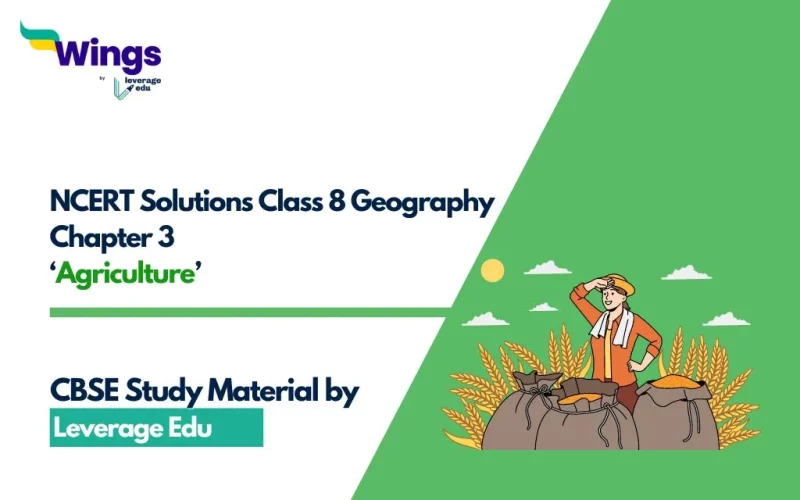We are providing NCERT Solutions Class 8 Geography Chapter 3 ‘Agriculture’ to help you navigate through your school exams. You can also download a PDF for important questions and answers for quick revision. This will help you prepare for your school exams. Let us get started!
Download the NCERT Solutions Class 8 Geography Chapter 3 Agriculture PDF Here!
Download Solutions of all the Chapters of Class 8 Geography:
NCERT Solutions Class 8 Geography Chapter 3 ‘Agriculture’
Here are NCERT Solutions of Class 8 Geography Chapter 3 ‘Agriculture’ to the questions in the exercise section of the lesson.
1. Answer the following questions.
(i) What is agriculture?
Answer: Agriculture is the science and art of cultivation on the soil, raising crops and rearing livestock. It is also called farming. Agriculture comes under the primary activity.
(ii) Name the factors influencing agriculture.
Answer: Soil, climate, topography, population etc are the factors that influence agriculture.
(iii) What is shifting cultivation? What are its disadvantages?
Answer: A plot of land is cleared by felling the trees and burning them. The ashes are then mixed with the soil and crops like maize, yam, potatoes and cassava are grown. After the soil loses its fertility, the land is abandoned and the cultivator moves to a new plot. It is practised in the thickly forested areas of the Amazon basin, tropical Africa, parts of southeast Asia and Northeast India. It is also known as ‘slash and burn’ agriculture.
The disadvantages of shifting cultivation are:
- It causes deforestation
- There is a loss of fertility in that particular land
- This leads to soil erosion
- Burning of trees causes air pollution
- The crops cultivated are insufficient for a large population.
(iv) What is plantation agriculture?
Answer: Plantations are a type of commercial farming where single crops of tea, coffee, sugarcane, cashew, rubber, banana or cotton are grown. Large amounts of labour and capital are required. The produce may be processed on the farm itself or in nearby factories. The development of a transport network is essential for such farming. Major plantations are found in the tropical regions of the world. Rubber in Malaysia, coffee in Brazil, tea in India and Sri Lanka are some examples.
(v) Name the fibre crops and name the climatic conditions required for their growth.
Answer: Fibre crops are Jute and Cotton. The climatic conditions necessary for the growth of jute are high temperature, high humidity and heavy rainfall. For the growth of cotton, light rainfall, high temperatures, and bright sunshine are essential.
2. Tick the correct answer.
(i) Horticulture means
(a) growing of fruits and vegetables
(b) primitive farming
(c) growing of wheat
Answer: (a) Growing of fruits and vegetables
(ii) Golden fibre refers to
(a) tea
(b) cotton
(c) jute
Answer: (c) Jute
(iii) Leading producers of coffee
(a) Brazil
(b) India
(c) Russia
Answer: (a)Brazil
3. Give reasons.
(i) In India, agriculture is a primary activity.
Answer: There are many regions in India that have fertile land which is good for agriculture. Two-thirds of India’s population is still dependent on agriculture. The population of India is dense and requires large-scale food production. Hence, agriculture is a primary activity in India.
(ii) Different crops are grown in different regions.
Answer: Different crops are grown in different regions because growing crops depends on many factors like the demand for produce, favourable topography of soil, type of climate, technology, amount of rainfall and labour.
4. Distinguish between the following.
(i) Primary activities and tertiary activities
Answer: Primary activities are those that include the extraction and production of natural resources. Agriculture, fishing and gathering are good examples.
Tertiary activities provide support to the primary and secondary sectors through services. Transport, trade, banking, insurance and advertising are examples of tertiary activities.
(ii) Subsistence farming and intensive farming.
Answer: Subsistence farming is practised to meet the needs of a farmer’s family. It includes low levels of technology and household labour. The output produced is small. Subsistence farming can be further classified as intensive subsistence and primitive subsistence farming.
In intensive farming, on a small land plot, a crop is cultivated using small tools and more labour. Climate with a large number of days with sunshine and fertile soils permits the growing of more than one crop annually on the same plot. It is prevalent in the thickly populated areas of the monsoon regions of south, southeast and east Asia. Examples include rice, wheat, maize, pulses, oilseeds, etc.
Download the NCERT Solutions Class 8 Geography Chapter 3 PDF Here!
Download Solutions of all the Chapters of Class 8 Geography:
Related Reads:
Explore Notes of All subjects of CBSE Class 8:
| CBSE Notes Class 8 English | CBSE Notes Class 8 History | CBSE Notes Class 8 Geography |
| CBSE Notes Class 8 Civics | CBSE Notes Class 8 Mathematics | CBSE Notes Class 8 Science |
FAQs
Q1. What is called agriculture?
Ans: Agriculture is the science and art of cultivation on the soil, raising crops and rearing livestock. It is also called farming. Agriculture comes under the primary activity.
Q2. What is major crop?
Ans: Some examples of major crops include coffee, tea, wheat, millet, rice, etc.
Q3. What are the two main types of farming?
Ans: There are two main types of farming: Subsistence farming and Commercial farming.
Follow Leverage Edu for complete study material on CBSE Notes of Class 8 Geography.
 One app for all your study abroad needs
One app for all your study abroad needs













